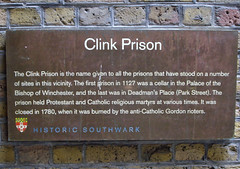The Clink
Commemorated on 2 plaques
The Clink. Most notorious medieval prison
Clink Prison Museum, Soho Wharf, Clink Street, London, United Kingdom where it sited
Clink Prison. The Clink Prison is the name given to all the prisons that have stood on a number of sites in this vicinity. The first prison in 1127 was a cellar in the Palace of the Bishop of Winchester, and the last was in Deadman's Place (Park Street). The prison held Protestant and Catholic religious martyrs at various times. It was closed in 1780, when it was burned by the anti-Catholic Gordon rioters.
Clink Prison Museum, Soho Wharf, Clink Street, London, United Kingdom where it sited

